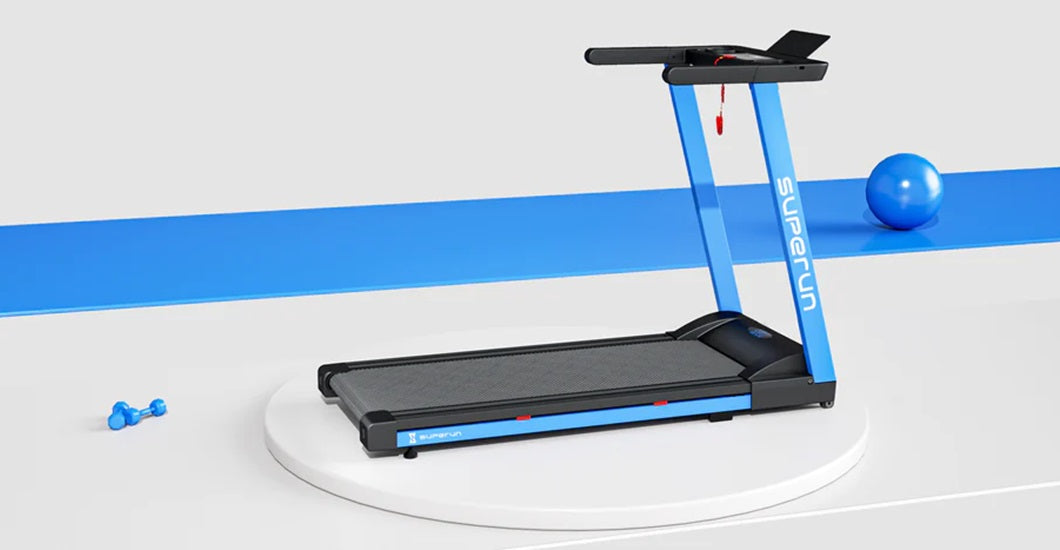In today's fast-paced world, staying committed to a fitness routine can be a challenge. This is where the treadmill comes to the rescue. Treadmill running offers a convenient and efficient way to stay active, allowing you to break a sweat and burn calories within the comfort of your own home or at the gym.
The importance of treadmill running extends beyond the realm of mere convenience. It contributes significantly to our overall health and well-being, enhancing cardiovascular fitness, aiding in weight management, and even boosting mental clarity. However, to truly maximize the benefits of treadmill running, it's crucial to address one pressing question: How long should I run on the treadmill?
The duration of your treadmill run is a pivotal factor that determines the effectiveness of your workout. Whether your goal is to shed those extra pounds, improve your cardiovascular health, or enhance your endurance, the amount of time you spend on the treadmill matters. Running too short or too long can yield suboptimal results, or worse, lead to injury and burnout. Finding that sweet spot - the ideal treadmill running duration - is key to reaping the full rewards of your efforts.
Why do you run a treadmill?
Running on a treadmill isn't just about mindless strides. It's a conscious choice driven by specific fitness goals. Understanding why you're running on a treadmill is the first step towards optimizing your workouts and finding the ideal treadmill running duration. Here, we explore three primary motivations for treadmill running:
Weight Loss
The Pursuit of a Healthier You
Treadmill running is a tried and true method for weight loss. If you're looking to shed extra pounds, this could be your path to a leaner, healthier you. Running on a treadmill is a highly effective way to burn calories, making it an integral component of any weight loss journey. The mechanics of treadmill running allow you to control crucial factors like speed and incline, enabling you to create a calorie deficit that's essential for weight loss.
When you maintain a consistent treadmill running routine and combine it with a balanced diet, you'll find that those stubborn pounds start to melt away. To determine the ideal treadmill running duration for weight loss, we'll delve deeper into calorie expenditure and how you can make the most of your treadmill sessions to achieve your weight loss goals.

Cardiovascular Health
The Heart of the Matter
One of the key reasons people choose to run on a treadmill is to improve their cardiovascular health. Regular aerobic exercise, such as treadmill running, has far-reaching benefits for your heart and circulatory system. It strengthens your heart muscle, lowers blood pressure, and reduces the risk of heart disease. By running on a treadmill, you enhance your body's ability to transport and use oxygen, leading to improved cardiovascular fitness.
When it comes to cardiovascular health, the duration of your treadmill runs plays a vital role. We'll explore how to structure your treadmill workouts to maximize the benefits for your heart and overall well-being.
Endurance Training
Unlocking Your Inner Athlete
For those with aspirations of becoming more proficient runners or athletes, the treadmill is a valuable training tool. Whether you're preparing for a marathon or triathlon, or simply aiming to boost your endurance, the controlled environment of a treadmill can help you achieve your goals. The ability to adjust variables like speed, incline, and duration makes it easier to gradually increase your running endurance and stamina.
To make the most of treadmill running for endurance training, we'll guide you through developing a structured approach to your workouts, ensuring that you're prepared to go the distance, both in training and in your chosen athletic pursuits.
In the following sections, we'll delve into each of these motivations for treadmill running, helping you tailor your workouts to your specific goals. Whether it's weight loss, cardiovascular health, or endurance training, understanding your "why" is the foundation for determining the ideal treadmill running duration for you.
Treadmill Running Duration for Weight Loss
Losing weight is a common fitness goal, and running on a treadmill can be a highly effective method to achieve it. To make the most of your treadmill workouts for weight loss, it's important to consider various factors, including your calorie-burning target, the role of intensity in fat-burning, and sample treadmill workouts. Let's dive into these aspects:
Establishing a Calorie-Burning Target
Before you step onto the treadmill to shed pounds, it's crucial to establish a clear calorie-burning target. Weight loss primarily depends on creating a calorie deficit, which means you burn more calories than you consume. To achieve this, consider the following steps:
- Determine Your Basal Metabolic Rate (BMR):
Calculate the number of calories your body needs at rest. There are several online BMR calculators available for this purpose.
- Set Realistic Goals:
Aim for a safe and sustainable weight loss of about 1 to 2 pounds per week. This typically requires a calorie deficit of 500 to 1,000 calories per day.
- Track Caloric Expenditure:
Monitor the number of calories burned during your treadmill workouts. Most treadmills provide an estimate, and you can also use fitness trackers or apps to help you keep track.
- Maintain a Balanced Diet:
Combine your treadmill workouts with a healthy, calorie-controlled diet. Make sure you're consuming enough nutrients to support your energy needs and overall well-being.

The Role of Intensity in Fat Burning
The intensity of your treadmill workout plays a significant role in fat burning. To maximize fat loss, consider the following tips:
- Interval Training:
High-Intensity Interval Training (HIIT) involves alternating between short bursts of high-intensity running and slower recovery periods. HIIT is particularly effective for fat burning and can help increase your post-workout calorie expenditure.
- Incorporate Inclines:
Running at an incline not only engages different muscle groups but also increases the intensity of your workout, leading to greater calorie burn.
- Stay in the Fat-Burning Zone:
For longer-duration workouts, aim to maintain a moderate intensity that keeps your heart rate in the fat-burning zone. This is typically around 60-70% of your maximum heart rate.
Sample Treadmill Workouts for Weight Loss
To give you a head start, here are two sample treadmill workouts for weight loss:
- Beginner's Fat-Burning Walk/Run:
Warm up with a 5-minute brisk walk at 3.5 mph.
Alternate between 2 minutes of walking at 3.5 mph and 1 minute of jogging at 5.5 mph.
Repeat the walk/jog cycle for 20-30 minutes.
Cool down with a 5-minute walk at 3.5 mph.
- Advanced HIIT Workout:
Warm up with a 5-minute jog at 6 mph.
Sprint for 30 seconds at 8-10 mph.
Recover with a 60-second walk at 3.5 mph.
Repeat the sprint/recovery cycle for 20-25 minutes.
Cool down with a 5-minute jog at 6 mph.
Treadmill Running Duration for Cardiovascular Health
Optimizing your treadmill running duration for cardiovascular health is a smart choice, as it offers a multitude of benefits for your heart and overall well-being. This section will explore the advantages of cardio exercise, understanding heart rate zones, and structuring a heart-healthy treadmill workout:
The Benefits of Cardio Exercise
Cardiovascular exercise, often referred to as "cardio," is a cornerstone of heart health. Here's why it's crucial:
- Improved Heart Health:
Cardio workouts, like treadmill running, strengthen the heart muscle. A stronger heart can pump blood more efficiently, reducing the risk of heart disease.
- Lower Blood Pressure:
Regular cardio exercise can help lower blood pressure, reducing stress on your arteries and heart.
- Enhanced Blood Circulation:
Cardio workouts improve blood circulation, ensuring that oxygen and nutrients are efficiently transported to your body's tissues.
- Better Cholesterol Profile:
Cardio exercise can increase HDL (good) cholesterol and reduce LDL (bad) cholesterol levels, leading to a healthier cholesterol profile.
- Weight Management:
Cardio workouts can contribute to weight loss or weight maintenance, which is important for heart health.
- Stress Reduction:
Cardio exercise releases endorphins, which reduce stress and improve mental well-being.
Heart Rate Zones for Optimal Cardiovascular Benefits
To maximize the cardiovascular benefits of your treadmill workout, it's important to understand heart rate zones:
- Resting Heart Rate:
Your resting heart rate is the number of times your heart beats per minute when you're at rest. It's a baseline for your cardiovascular fitness.
- Target Heart Rate Zone:
This is the ideal heart rate range you want to achieve during your workout to improve cardiovascular health. It's typically calculated as a percentage of your maximum heart rate.
- Maximum Heart Rate:
Your maximum heart rate is estimated by subtracting your age from 220. For example, if you're 30 years old, your estimated maximum heart rate is 190 beats per minute.
- Aerobic vs. Anaerobic Zones:
The lower end of your target heart rate zone is the aerobic zone, where you burn fat and improve endurance. The higher end is the anaerobic zone, where you improve fitness and increase cardiovascular capacity.

Structuring a Heart-Healthy Treadmill Workout
Here's how to structure a heart-healthy treadmill workout:
- Warm-up:
Start with a 5-10 minute warm-up at a comfortable pace to gradually increase your heart rate.
- Aerobic Zone:
To improve heart health, aim for 20-60 minutes of continuous running within your target heart rate zone (usually 60-70% of your maximum heart rate).
- Cool Down:
Finish with a 5-10 minute cool-down at a slower pace to gradually lower your heart rate.
- Interval Training:
Incorporate interval training (e.g., 1-2 minutes of faster running followed by 1-2 minutes of recovery) to challenge your cardiovascular system.
- Progression:
Over time, increase the duration or intensity of your workouts to continue challenging your heart and improving your cardiovascular fitness.
Treadmill Running Duration for Endurance Training
For those aiming to enhance their endurance, treadmill running can serve as a valuable training tool. This section will explore strategies for increasing running duration for endurance, the incorporation of interval training, and how to build a progressive endurance plan:
Increasing Running Duration for Endurance
Building endurance involves gradually extending the duration of your runs. Here's how to do it:
- Start with a Baseline:
Begin by determining your current endurance level. This could be the longest distance or duration you can comfortably run at a steady pace.
- Incremental Increases:
Increase your running duration by 5-10% each week. This gradual progression minimizes the risk of injury and helps your body adapt.
- Mix in Long Runs:
Include one long run in your weekly routine. This run should be longer than your regular workouts and should increase incrementally over time.
- Listen to Your Body:
Pay attention to any signs of fatigue or overtraining. It's essential to balance intensity with recovery.
Incorporating Interval Training
Interval training is a potent method to boost endurance. Here's how to incorporate it into your treadmill workouts:
- Vary Intensity:
Alternate between periods of high-intensity running (e.g., sprinting) and low-intensity recovery (e.g., jogging or walking).
- Sample Interval Workout:
Start with a 5-minute warm-up. Then, run at a fast pace (close to your maximum effort) for 1-2 minutes. Follow this with a 2-3 minute recovery interval at a slower pace. Repeat the cycle several times, gradually increasing the number of intervals as your endurance improves.
- Progressive Overload:
Over time, increase the intensity and duration of your high-intensity intervals to continue challenging your endurance.
Building a Progressive Endurance Plan
To build a progressive endurance plan, follow these steps:
- Set Clear Goals:
Define your endurance goals, such as running a longer distance or completing a specific race.
- Create a Weekly Schedule:
Plan your weekly workouts, incorporating both long runs and interval training.
- Gradual Progression:
Increase your weekly mileage or duration by no more than 10%. For example, if you're running 20 miles per week, aim for 22 miles the next week.
- Rest and Recovery:
Include rest days and lighter workouts to allow your body to recover. Recovery is vital for endurance gains.
- Periodization:
Periodize your plan by incorporating cycles of harder and easier training to prevent burnout and ensure consistent progress.
- Nutrition and Hydration:
Pay attention to your diet and hydration, especially for longer endurance runs.
- Monitoring and Assessment:
Regularly evaluate your progress by tracking your running duration and performance. Adjust your plan based on your results.
In the quest for health and fitness, the treadmill stands as a versatile companion, offering a pathway to a stronger, healthier you. Yet, the critical question lingers: "How long should I run on the treadmill?"
From weight loss to cardiovascular health and endurance training, treadmill running holds the potential to sculpt your fitness journey, provided you comprehend your motivations and goals.






Leave a comment
All comments are moderated before being published.
This site is protected by hCaptcha and the hCaptcha Privacy Policy and Terms of Service apply.